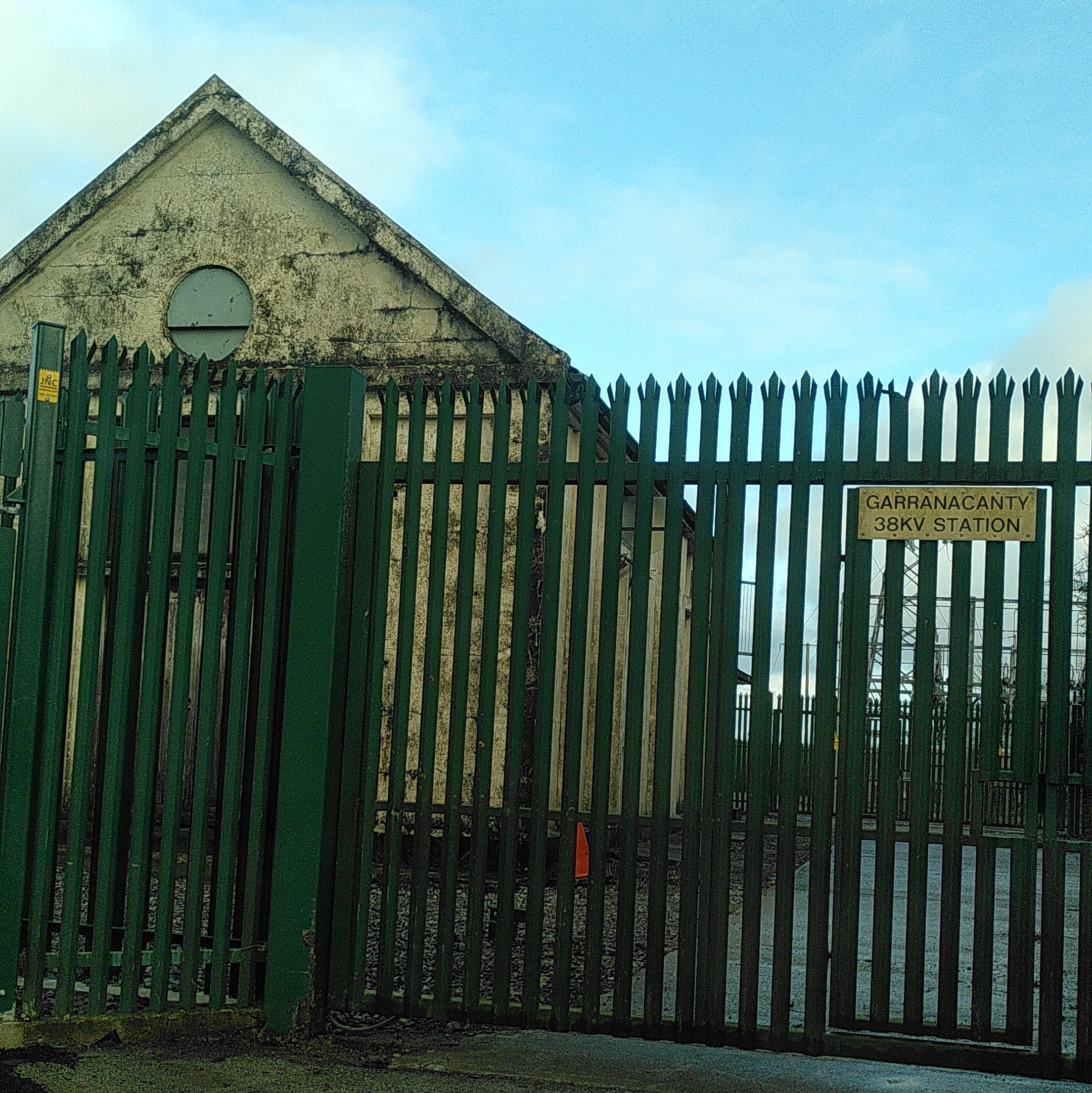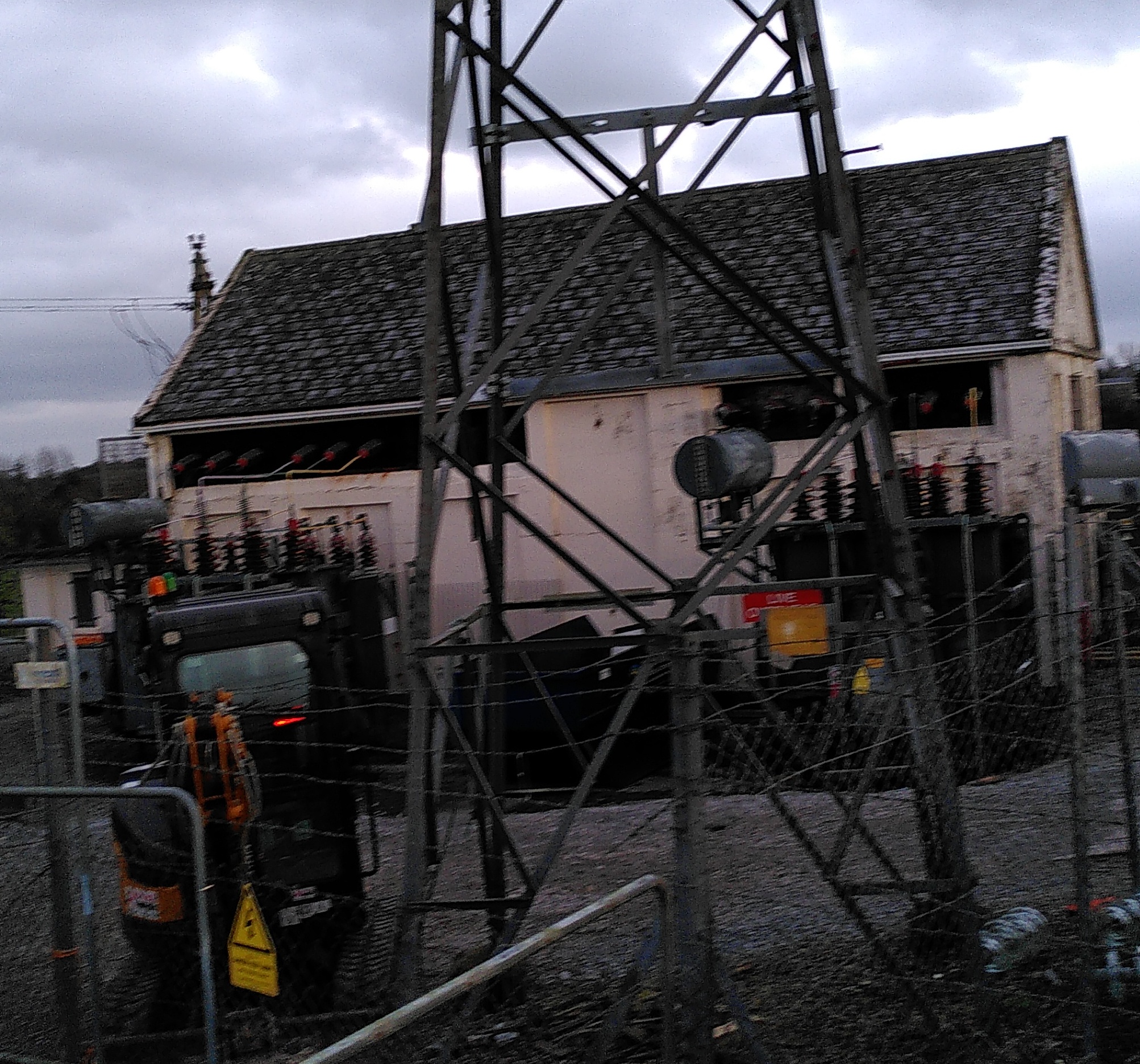So I'm back again, randomly posting on this blog after a few years, about another new topic… This time, the topic is historic electricity infrastructure in Ireland.
As part of the Shannon Scheme almost a century ago, a 38-kV transmission network was built around the then Irish Free State, in four loops. This network was fed into by 110-kV transformer stations at Ardnacrusha (the hydro station), Kilbarry (Cork), and Inchicore (Dublin), and in turn fed into a 10-kV distribution network at sixty-five strategically-placed substations around the country. The map of these stations can be seen in the 1930 ESB Annual Report, available (together with all the others) from the ESB Archives website.
These sixty-five stations were built according to a standard template, involving a "power house" containing 38-kV switchgear on one side and 10-kV on the other (which voltage was left or right varied from site to site), and a small control room at the back. The switchgear was all supplied by Siemens-Schuckert, and has proven itself very robust, as many of these houses were still operating right up to the 2010s, and some even into the 2020s.
However, all equipment must eventually reach the end of its service life, and there are now only a few such houses left in commission. One of the last remaining stations, in Rathkeale (known as "Kyletaun") was fully retired from service just last week. Like many of the other houses, its transformer capacity had been increased to 10 MVA over the years. Most of the outlets had also been upgraded from 10 kV to 20 kV, by installing three step-up interface transformers in the yard and using extra reclosers to switch the higher-voltage feeders.
The 10-MVA transformer capacity appears to have represented an absolute maximum for the 10-kV switchgear in these old power houses, as the only stations that surpassed this (Balbriggan and Bray) have replaced the 10-kV side entirely, while still using the original 38-kV gear. In one way, this 10-MVA switchgear rating represents pretty impressive future-proofing: when the stations were first built, the total transformer capacity across the entire 38-kV network was a mere 53 MVA, i.e. an average of 0.8 MVA per station! However, in more recent years, the area served by Kyletaun frequently scraped this ceiling at peak demand.
Now the region has been moved over to a more streamlined setup, with 20 MVA of 38/20-kV transformer capacity installed in the nearby Rathkeale 110-kV substation, as well as two step-down 20/10-kV interface transformers. The latter transformers serve Rathkeale town, whose supply had never been upgraded to 20 kV.
So how many power houses are left?
For the last few weeks, I have been working on a spreadsheet listing all sixty-five original power houses, and trying to figure out when each one was decommissioned and demolished. Pretty soon, I figured out that in most cases, the best I could offer was a date range, which is still quite informative. To narrow down these date ranges as much as possible, I relied on several publicly-available (though in most cases copyrighted) sources of information:
- The aforementioned ESB Annual Reports
- World Imagery Wayback from Esri
- Historical aerial imagery on the Irish Townland and Historical Map Viewer
- Google Earth historical imagery (available using the Google Earth Pro desktop program)
- Google Street View historical imagery (available using the Google Maps web application)
- ESB Heatmap spreadsheet from November 2020
- ESB SLR reports from 2016-2017, 2021-2022 and 2022-2023
- ESB schematics of the southern, midwest, northern and Dublin 38-kV networks from August 2003 [*]
- Planning file metadata from various local authorities available online
- Visiting some of the stations myself :)
From this, it looks like the only four original stations left fully in service (both 38-kV and 10-kV switchgear) as of early 2024 are:
- Garden City (Gorey), at 10 MVA (2×5 MVA) transformer capacity
- Barntown, at 5 MVA transformer capacity
- Cobh, at 10 MVA (2×5 MVA) transformer capacity
- Tuam South (Tuam), at 5 MVA transformer capacity
In fact, there may be even fewer (or none), since in most cases I'm still relying on sources from last year or the year before. Some or all may indeed have been decommissioned at the same time as Kyletaun. Note that Balbriggan and Bray are not included on this list because only the 38-kV sides of those houses are still being used.
The spreadsheet is available to download for anyone who is interested: https://vigovproductions.net/history/Original_Powerhouse_Status.ods
What happens to decommissioned power houses?
Many of the old switchgear buildings were eventually demolished after being decommissioned, sometimes with many years of delay. In particular, the one in Charleville (known as "Rathgoggin") had come to be considered an "iconic landmark" in the town, but was nevertheless demolished in 2023 (having been decommissioned in 2020).
On the other hand, some long-decommissioned houses were still standing as of last month, for example the one in Garranacanty (Tipperary):
While the house at Garranacanty doesn't appear to be in great condition, others have been repainted and apparently repurposed, for example the one in Corrawarrin (Ennis):
M-deClé, Repainted ESB substation Corrawarrin front, CC BY-SA 4.0
According to the ESB's planning application, they do indeed intend to demolish the Kyletaun power house at some point. In the meantime, I'll leave this picture of its current condition for posterity:
| [*] | Updated 6 March to fix a typo: this originally read "August 2023", which of course is completely wrong. I actually noticed it the night before updating the article, i.e. exactly one month after publishing it – d'oh! |


